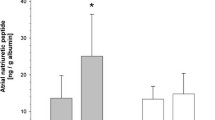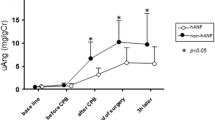Abstract
The present study investigates why shedding of the endothelial glycocalyx occurs both in patients undergoing on- and off-pump coronary artery bypass surgery. Release of atrial natriuretic peptide (ANP) was of special interest, because ANP initiates shedding ex vivo. Three major constituents of the glycocalyx (syndecan-1, heparan sulfate and hyaluronan) were measured in arterial blood of patients undergoing coronary artery bypass surgery with (n = 15) and without (n = 15) cardiopulmonary bypass at various phases of the procedure. Additionally, the levels of the inflammatory cytokines interleukin (IL)-6, -8, and -10 and of ANP were evaluated. Elevations of all three components of the glycocalyx were detected in blood of patients undergoing on- (maximum increases: syndecan-1 15-fold, heparan sulfate ninefold, hyaluronan fivefold basal) and off-pump (maximum increases: syndecan-1 fourfold, heparan sulfate twofold, hyaluronan threefold basal) coronary artery surgery. Maximum ANP concentrations increased three- and fourfold basal in on- and off-pump coronary artery surgery, respectively (P < 0.05). There were significant increases in the three cytokine concentrations in both on- (maximum increases: IL-6 146-fold, IL-8 23-fold, IL-10 238-fold basal) and off-pump (maximum increases: IL-6 77-fold, IL-8 eightfold, IL-10 58-fold basal) coronary artery surgery. However, the elevations of ANP preceded those of the cytokines and coincided with or even preceded shedding of the human endothelial glycocalyx in both surgical procedures. These data suggest that release of ANP may lead to perturbation of the endothelial glycocalyx in both on- and off-pump coronary artery bypass surgery.





Similar content being viewed by others
References
Ahluwalia A, MacAllister RJ, Hobbs AJ (2004) Vascular actions of natriuretic peptides. Cyclic GMP-dependent and -independent mechanisms. Basic Res Cardiol 99:83–89. doi:10.1007/s00395-004-0459-6
Baxter GF (2004) The natriuretic peptides. Basic Res Cardiol 99:71–75. doi:10.1007/s00395-004-0457-8
Becker BF, Chappell D, Bruegger D, Annecke T, Jacob M (2010) Therapeutic strategies targeting the endothelial glycocalyx: acute deficits, but great potential. Cardiovasc Res 87:300–310. doi:10.1093/cvr/cvq137
Becker BF, Chappell D, Jacob M (2010) Endothelial glycocalyx and coronary vascular permeability: the fringe benefit. Basic Res Cardiol 105:687–701. doi:10.1007/s00395-010-0118-z
Bruegger D, Rehm M, Abicht J, Paul JO, Stoeckelhuber M, Pfirrmann M, Reichart B, Becker BF, Christ F (2009) Shedding of the endothelial glycocalyx during cardiac surgery: on-pump versus off-pump coronary artery bypass graft surgery. J Thorac Cardiovasc Surg 138:1445–1447. doi:10.1016/j.jtcvs.2008.07.063
Bruegger D, Jacob M, Rehm M, Loetsch M, Welsch U, Conzen P, Becker BF (2005) Atrial natriuretic peptide induces shedding of endothelial glycocalyx in coronary vascular bed of guinea pig hearts. Am J Physiol Heart Circ Physiol 289:H1993–H1999. doi:10.1152/ajpheart.00218.2005
Bruegger D, Rehm M, Jacob M, Chappell D, Stoeckelhuber M, Welsch U, Conzen P, Becker BF (2008) Exogenous nitric oxide requires an endothelial glycocalyx to prevent postischemic coronary vascular leak in guinea pig hearts. Crit Care 12:R73. doi:10.1186/cc6913
Chappell D, Hofmann-Kiefer K, Jacob M, Rehm M, Briegel J, Welsch U, Conzen P, Becker BF (2009) TNF-alpha induced shedding of the endothelial glycocalyx is prevented by hydrocortisone and antithrombin. Basic Res Cardiol 104:78–89. doi:10.1007/s00395-008-0749-5
Chappell D, Jacob M, Hofmann-Kiefer K, Bruegger D, Rehm M, Conzen P, Welsch U, Becker BF (2007) Hydrocortisone preserves the vascular barrier by protecting the endothelial glycocalyx. Anesthesiology 107:776–784. doi:10.1097/01.anes.0000286984.39328.96
Chappell D, Jacob M, Paul O, Mehringer L, Newman W, Becker BF (2008) Impaired glycocalyx barrier properties and increased capillary tube haematocrit. J Physiol 586:4585–4586. doi:10.1113/jphysiol.2008.160648
Chappell D, Jacob M, Paul O, Rehm M, Welsch U, Stoeckelhuber M, Conzen P, Becker BF (2009) The glycocalyx of the human umbilical vein endothelial cell: an impressive structure ex vivo but not in culture. Circ Res 104:1313–1317. doi:10.1161/CIRCRESAHA.108.187831
Constantinescu AA, Vink H, Spaan JA (2003) Endothelial cell glycocalyx modulates immobilization of leukocytes at the endothelial surface. Arterioscler Thromb Vasc Biol 23:1541–1547. doi:10.1161/01.ATV.0000085630.24353.3D
Curry FR (2005) Atrial natriuretic peptide: an essential physiological regulator of transvascular fluid, protein transport, and plasma volume. J Clin Invest 115:1458–1461. doi:10.1172/JCI25417
Curry FR, Rygh CB, Karlsen T, Wiig H, Adamson RH, Clark JF, Lin YC, Gassner B, Thorsen F, Moen I, Tenstad O, Kuhn M, Reed RK (2010) Atrial natriuretic peptide modulation of albumin clearance and contrast agent permeability in mouse skeletal muscle and skin: role in regulation of plasma volume. J Physiol 588:325–339. doi:10.1113/jphysiol.2009.180463
Czarnowska E, Karwatowska-Prokopczuk E (1995) Ultrastructural demonstration of endothelial glycocalyx disruption in the reperfused rat heart. Involvement of oxygen free radicals. Basic Res Cardiol 90:357–364. doi:10.1007/BF00788496
Henry CB, Duling BR (2000) TNF-alpha increases entry of macromolecules into luminal endothelial cell glycocalyx. Am J Physiol Heart Circ Physiol 279:H2815–H2823
Jacob M, Bruegger D, Rehm M, Stoeckelhuber M, Welsch U, Conzen P, Becker BF (2007) The endothelial glycocalyx affords compatibility of Starling’s principle and high cardiac interstitial albumin levels. Cardiovasc Res 73:575–586. doi:10.1016/j.cardiores.2006.11.021
Kuhn M (2004) Molecular physiology of natriuretic peptide signalling. Basic Res Cardiol 99:76–82. doi:10.1007/s00395-004-0460-0
Massoudy P, Zahler S, Becker BF, Braun SL, Barankay A, Meisner H (2001) Evidence for inflammatory responses of the lungs during coronary artery bypass grafting with cardiopulmonary bypass. Chest 119:31–36. doi:10.1378/chest.119.1.31
Mulivor AW, Lipowsky HH (2004) Inflammation- and ischemia-induced shedding of venular glycocalyx. Am J Physiol Heart Circ Physiol 286:H1672–H1680. doi:10.1152/ajpheart.00832.2003
Nelson A, Berkestedt I, Schmidtchen A, Ljunggren L, Bodelsson M (2008) Increased levels of glycosaminoglycans during septic shock: relation to mortality and the antibacterial actions of plasma. Shock 30:623–627. doi:10.1097/SHK.0b013e3181777da3
Nieuwdorp M, van Haeften TW, Gouverneur MC, Mooij HL, van Lieshout MH, Levi M, Meijers JC, Holleman F, Hoekstra JB, Vink H, Kastelein JJ, Stroes ES (2006) Loss of endothelial glycocalyx during acute hyperglycemia coincides with endothelial dysfunction and coagulation activation in vivo. Diabetes 55:480–486. doi:10.2337/diabetes.55.02.06.db05-1103
Parish CR (2005) Heparan sulfate and inflammation. Nat Immunol 6:861–862. doi:10.1038/ni0905-861
Parish CR (2006) The role of heparan sulphate in inflammation. Nat Rev Immunol 6:633–643. doi:10.1038/nri1918
Pries AR, Secomb TW, Gaehtgens P (2000) The endothelial surface layer. Pflugers Arch 440:653–666. doi:10.1007/s004240000307
Rehm M, Bruegger D, Christ F, Conzen P, Thiel M, Jacob M, Chappell D, Stoeckelhuber M, Welsch U, Reichart B, Peter K, Becker BF (2007) Shedding of the endothelial glycocalyx in patients undergoing major vascular surgery with global and regional ischemia. Circulation 116:1896–1906. doi:10.1161/CIRCULATIONAHA.106.684852
Rehm M, Haller M, Orth V, Kreimeier U, Jacob M, Dressel H, Mayer S, Brechtelsbauer H, Finsterer U (2001) Changes in blood volume and hematocrit during acute preoperative volume loading with 5% albumin or 6% hetastarch solutions in patients before radical hysterectomy. Anesthesiology 95:849–856
Reitsma S, Slaaf DW, Vink H, van Zandvoort MA, oude Egbrink MG (2007) The endothelial glycocalyx: composition, functions, and visualization. Pflugers Arch 454:345–359. doi:10.1007/s00424-007-0212-8
Sabrane K, Kruse MN, Fabritz L, Zetsche B, Mitko D, Skryabin BV, Zwiener M, Baba HA, Yanagisawa M, Kuhn M (2005) Vascular endothelium is critically involved in the hypotensive and hypovolemic actions of atrial natriuretic peptide. J Clin Invest 115:1666–1674. doi:10.1172/JCI23360
Schreier B, Borner S, Volker K, Gambaryan S, Schafer SC, Kuhlencordt P, Gassner B, Kuhn M (2008) The heart communicates with the endothelium through the guanylyl cyclase-A receptor: acute handling of intravascular volume in response to volume expansion. Endocrinology 149:4193–4199. doi:10.1210/en.2008-0212
Svennevig K, Hoel T, Thiara A, Kolset S, Castelheim A, Mollnes T, Brosstad F, Fosse E, Svennevig J (2008) Syndecan-1 plasma levels during coronary artery bypass surgery with and without cardiopulmonary bypass. Perfusion 23:165–171. doi:10.1177/0267659108098215
Vink H, Constantinescu AA, Spaan JA (2000) Oxidized lipoproteins degrade the endothelial surface layer: implications for platelet-endothelial cell adhesion. Circulation 101:1500–1502. doi:10.1161/01.CIR.101.13.1500
Wang L, Fuster M, Sriramarao P, Esko JD (2005) Endothelial heparan sulfate deficiency impairs L-selectin- and chemokine-mediated neutrophil trafficking during inflammatory responses. Nat Immunol 6:902–910. doi:10.1038/ni1233
Yancy CW (2007) Benefit-risk assessment of nesiritide in the treatment of acute decompensated heart failure. Drug Saf 30:765–781
Zahler S, Massoudy P, Hartl H, Hahnel C, Meisner H, Becker BF (1999) Acute cardiac inflammatory responses to postischemic reperfusion during cardiopulmonary bypass. Cardiovasc Res 41:722–730. doi:10.1016/S0008-6363(98)00229-6
Acknowledgments
This study was performed using departmental research funding provided by the Government of Bavaria (Bavarian State Ministry of Science, Research, and the Arts, Munich) and a competitive grant of the Friedrich-Baur-Foundation, Munich, Germany.
Conflict of interest
The authors declare that they have no conflict of interest.
Author information
Authors and Affiliations
Corresponding author
Rights and permissions
About this article
Cite this article
Bruegger, D., Schwartz, L., Chappell, D. et al. Release of atrial natriuretic peptide precedes shedding of the endothelial glycocalyx equally in patients undergoing on- and off-pump coronary artery bypass surgery. Basic Res Cardiol 106, 1111–1121 (2011). https://doi.org/10.1007/s00395-011-0203-y
Received:
Revised:
Accepted:
Published:
Issue Date:
DOI: https://doi.org/10.1007/s00395-011-0203-y




